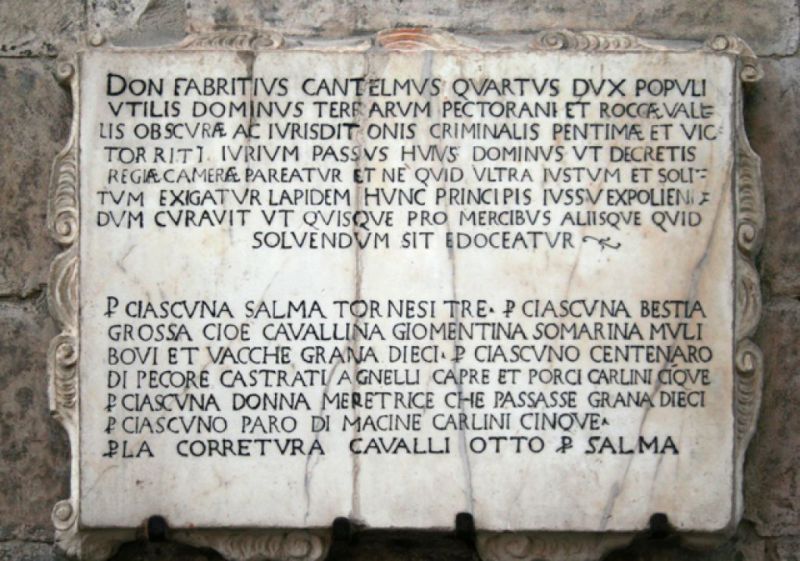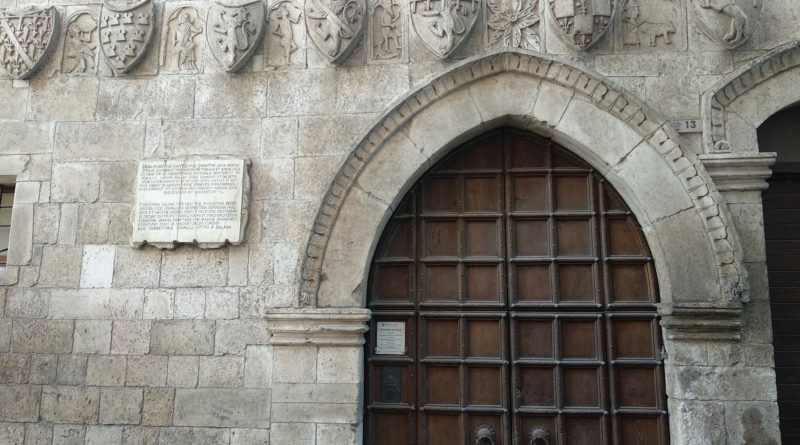🇬🇧 Historic buildings
Taverna Ducale (Ducal Tavern)

The “Taverna Ducale” is a complex of typically late medieval house-shops that were built along the lower street, which led merchants to the square; the street then proceeded northwards towards the Tremonti Gorge, or westwards towards the Pescara River. But leaving the square, Lord Restaino II Cantelmo wanted the most characteristic of the new buildings, later to become the Taverna Ducale, to be built, initially intended for toll collection. The small building repeats the typological layout of Abruzzo’s house-shops of the 14th century, such as the so-called ‘Cancelle’ of L’Aquila. On the ground floor, there are two gates; the larger one gives access to the large room, the second, smaller one allowed access to the upper floor. The arch at the smaller entrance refers to portals found in L’Aquila and especially in Naples. The provenance of this profile is in fact Neapolitan, but its origin is probably Sienese. Other portals of Sienese derivation are also present in Abruzzo in Penne, Guardiagrele and Celano. The Popolese tavern, on the other hand, proposes an intermediate moment in the evolution that matured in Naples. The entire façade is executed in squared ashlars of local limestone up to the height of a cornice that runs along the entire front and also acts as a sill for a pair of double lancet windows divided in the centre by a small pillar; each of them has above a central column pointed arches that were once polylobed and elegantly executed decorations in low relief, depicting a heraldic insignia of the Cantelmo family.
Taverna dell’Università (University Tavern)

Next to the Taverna Ducale is the Taverna dell’Università (1574), which the municipal authorities of the time, overcoming the opposition of the feudal lord with whom they competed, wanted to enlarge and embellish <<per meliore comodità de viandanti et passegierj>>. The façade of the small building shows a round-arched portal surmounted by a quadrangular window, both framed by diamond-pointed ashlars (an uncommon motif in Abruzzo that appears, in Sulmona, on the portal of the agricultural bank building) and in the keystone of the arch, to rival the numerous coats of arms of the adjacent building, the insignia of the University of Popoli.
Source: Popoli città d’arte e natura, Carsa Edizioni
Authors: Federico Palmerini, Roberto Flauto, Andrea De Melis
Work-school project with the “Amedeo di Savoia” high school (Popoli)
Palazzo Ducale (Ducal Palace)

The feudal rule of the Cantelmo family in Popoli began in 1268 with Giacomo I, but it was not until 1461 that Giovanni Cantelmo was definitively invested with the title of Count of Popoli, and since this date corresponds well with the architectural features of the building, it can be assumed that it was he who began the palatial transformation of pre-existing residential cells. In 1479, Restaino Cantelmo succeeded his father as feudal lord and carried out the bulk of the expansion and modernisation of the palace. This represents the aggregation of a series of small buildings built on the slope between the old Market Square (now Piazza della Libertà) and the street that ends in front of the parish church of S. Lorenzo (now Via Giordano Bruno). The result is a stepped structure of the block: the ground floor rooms are accessed downhill; access to the upper floors is uphill. The spatial configuration of the building is articulated around several constituent elements: the entrance to the courtyard through a barrel-vaulted entrance hall; the west (main) courtyard; the south courtyard; the east courtyard; the façade on the street.
Set apart from the square the palace overlooks, the main entrance, leading to the west courtyard, is located on what is now Via Cavour. The façade on Via Cavour follows the course of the ground, according to the slope of the public steps. Access to the palace is through an entrance hall bordered externally by a round-headed portal marked by cushion-shaped ashlars and framed by a torus. The rusticated portal is set in a classical frame concluded by a frieze and a simple cornice. At the corner of Via Cavour and Piazza della Libertà, a void can be seen today, the result of World War II bombing that led to the destruction of several houses outside the palace. The volumetry of the block is thus undermined, and it now appears devoid of its corner solution.
After passing through the large rusticated portal on Via Cavour, a barrel-vaulted entrance hall leads to the trapezoidal-plan west (main) courtyard from which one enters the ground floor basement and the noble flats on the upper floors. With its three-arched loggia and a series of well-designed windows, this space well represents Abruzzi Renaissance architecture and characterises the entire complex in a monumental sense. The loggia originally constituted a connecting space between the different flats, built in pre-existing buildings and therefore not perfectly aligned with each other, open to the courtyard. There are in fact two carved stone portals: the one on the east wall bears the Caetani family coat of arms and therefore most probably led into the flat reserved for Duchess Giovannella Caetani, Restaino Cantelmo’s mother; the portal to the south, on the other hand, bears the Cantelmo family coat of arms and is smaller in size. The presence of a reused Roman sculpture, a head of Jupiter, probably from the nearby site of ancient Corfinium, suggests that this was the main entrance to the flats, probably of the duke himself. Although not excessive in size, the work is of high quality, comparable to some of the interior doors of the Ducal Palace in Urbino for its confident sense of proportion.
The south courtyard is a small space with a roughly rectangular shape, characterised by a double level of loggias. On the ground floor, under the loggia, there is a moulded portal of which only the piers remain, while the architrave with the coat of arms of the Cantelmo family, found nearby during the survey phase, has been replaced by a modern brick arch. Presumably this area of the Ducal Palace was the hub of the connections between the various flats.
The east courtyard, rectangular in shape, must have been a space reserved for the inhabitants of the ducal residence: in fact, it does not appear to have any direct entrance from outside the palace, but only accesses from inside. The historical architectural value it once probably had has been lost due to the many tamperings it has undergone; signs of the transformations that took place under the Cantelmo family are given by four windows on the first level, which recall those of the main courtyard.
The façade on today’s Piazza della Libertà did not look like it does today. It probably had a non-rectilinear profile that followed the course of the pre-existing cells, in much the same way as the west front of the main courtyard. In the 1830s, the square known as St. George’s Square, by then the centre of all commercial, civic, administrative and social activity, took on a more ornate appearance with the reconstruction of the façade of the Ducal Palace by the Muzj family. The 19th-century façade, still visible today, is organised on three levels and has seven bays enclosed by pilasters; the central one is emphasised by the large rusticated portal and the balcony on the first floor, which is wider than the others. The ground floor is delimited by the stone base and rusticated ashlar with staggered recourses; the crowning is a strongly projecting stucco cornice. On the ground floor, each bay corresponds to a covered room with a lunetted barrel vault, each of which is still used for commercial activities, the access to which is characterised by segmental stone portals. The upper floors, corresponding to four flats, two on the right and two on the left, are characterised on the façade by a succession of stone balconies joined by stucco string courses: those on the first floor are slightly wider and have a richer decoration, showing that this was probably the privileged level; the second floor, on the other hand, corresponds to the representative flats, which, on the main courtyard, present a series of 15th-century windows with classically decorated frames with ovoli and spindle mouldings, which nevertheless – due to the three-lobed pointed arches and in one case the lowered arch inserted in the quadrangular openings – represent a good example of the coexistence of the late Gothic artistic language with forms of Renaissance derivation in the regions of the former Kingdom of Naples.
Source: Il Borgo Ritrovato – Il palazzo Ducale di Popoli, dalla conoscenza alla conservazione, Casa Editrice Tinari
Authors: Silvio Cafarelli, Giusy Santilli
Tour of the historic buildings of Popoli
Made by the volunteers of the Popoli Civil Service


